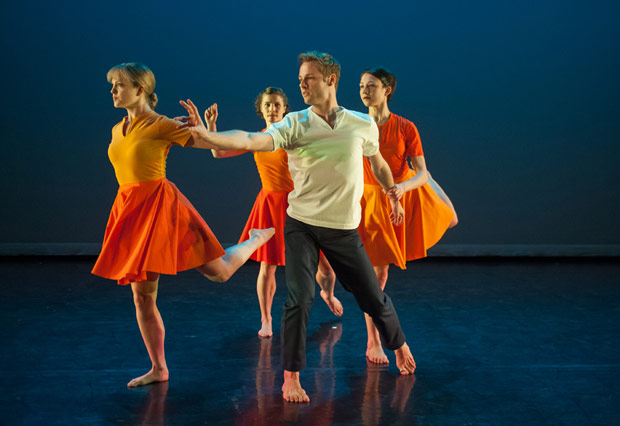
© Stephanie Berger. (Click image for larger version)
Mark Morris Dance Group
Italian Concerto, A Wooden Tree, Jenn and Spencer, Crosswalk
Washington, George Mason University,
23 February 2014
markmorrisdancegroup.org
cfa.gmu.edu
Mark Morris is one of the most musically astute and insightful choreographers in modern dance. What makes his company, Mark Morris Dance Group (MMDG), which he founded nearly 35 years ago, stand out from the rest of today’s modern troupes is that each MMDG program features top-notch live musical performances.
Founded in 1996, MMDG Music Ensemble is an integral part of the company’s artistic and performing life. So it was no surprise that the recent performance of MMDG at the George Mason University’s Center for the Arts proved a special treat for dancegoers and music lovers alike. The Music Ensemble – Colin Fowler (piano), Georgy Valtchev (violin), and Todd Palmer (clarinet) – delivered a concert-hall quality performance, playing a program that featured music by J.S. Bach, Henry Cowell and Carl Maria von Weber. The evening offered a sampler of Morris’s newly-minted works (A Wooden Tree, Jenn and Spencer, and Crosswalk, all made in 2012-13) and his splendid Italian Concerto from 2007.
Italian Concerto made a perfect program opener. This piece is Morris’s ingenious take on Bach’s famous Italian Concerto in F Major – an enduring staple of Baroque piano repertoire, rivaled in popularity only perhaps by the Goldberg Variations. With supreme musical intelligence and affection, the choreographer gives physical form to the sparkling vitality and somber lyricism of the music, offering a deeply personal interpretation of Bach and by doing so revealing hidden nuances and intricacies in the music itself and illuminating the composer’s wit and humor hardly apparent before.

© Stephanie Berger. (Click image for larger version)
Two vibrant, frolicking duets danced to the concerto’s first and last movements frame a stark and pensive male solo set to the central Adagio. The ballet’s opening – brisk allegro – is full of bright, irresistible energy. The dancers (Lauren Grant and Aaron Loux), dressed in bright colors of orange and red, skip and leap about the stage, joyfully tapping Bach’s exhilarating rhythms with their feet. They jazzily sway their hips. They ritualistically raise their hands, punching the air with their proud fists, their feet firmly clenching the floor. Their movements are spontaneous and fresh. Their quirky and amusing gestures often evoke those of children at play. It’s Bach like you have never heard and seen before.
The ballet’s middle part brings a startling contrast – and a darker edge – to the invigorating and sunny opening. Here, the lonely man (Sam Black) – a mysterious figure in black who appeared only briefly at the beginning of the dance – takes center stage. (When the piece premiered in 2007, the choreographer himself danced this solo.) His slow movements are haunting and utterly captivating. He has a measured walk and a meditative expression, simplicity and the directness of a Greek philosopher. For a moment, he stands motionless, facing the audience. Imitating the measured pulse of the left-hand piano accompaniment, he taps with his palm on his chest as if gesturing: “This is my heart.” Throughout the piece, Morris takes a simple movement idea and develops it into a dance language that is rich, sophisticated and full of deep philosophical meaning. In one scene, the man is a fisherman, throwing a fishing line over his shoulder into a river and pulling out with all his might his imaginary catch. In another, he is a prophet, his raised fist symbolically opens, each finger outstretched as rays of the rising sun.
The concerto’s finale – Presto – brings a second vigorous duet (Rita Donahue and Dallas McMurray) and delivers a stirring conclusion, with all five dancers joining together on stage, to this immensely enjoyable and ultimately unforgettable dance.
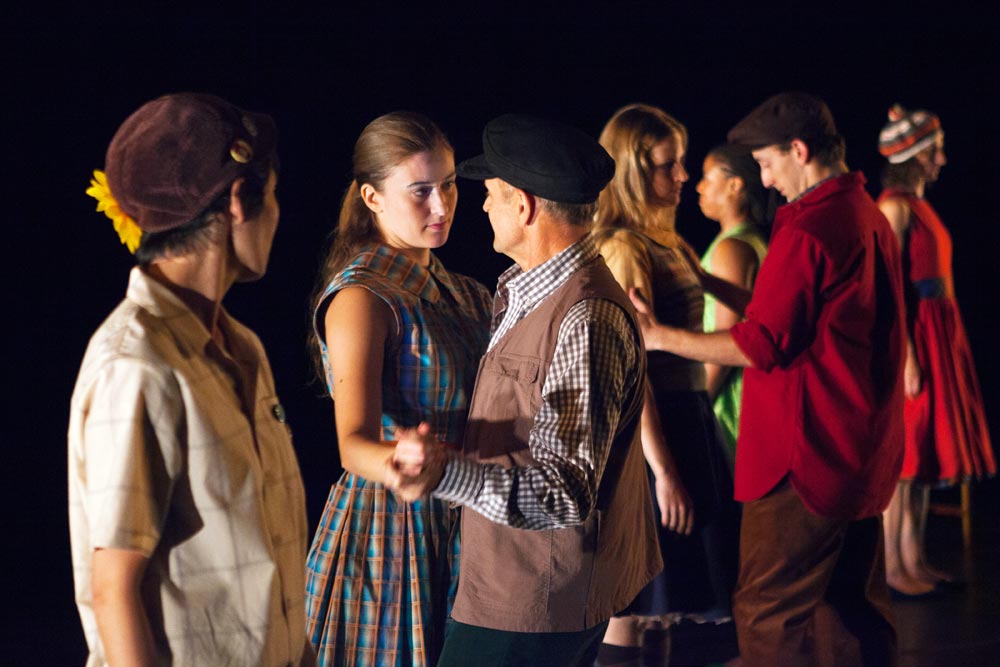
© Tim Summers. (Click image for larger version)
A Wooden Tree, the second of Morris’s works on the program, is a witty collage of 14 miniature dances as humorous and eccentric as the Ivor Cutler songs and recitations that inspired it. This is a great vehicle for the talented Morris troupe to relax in and have great fun. The excellent cast of eight dancers was led by Sam Black in the role originated by Mikhail Baryshnikov. The dance depicts a bunch of small-town folks dressed in outrageously eccentric garb (by Elizabeth Kurtzman), bopping onstage in a kaleidoscopic manner and enacting Cutler’s nutty lyrics. Among the songs included in the soundtrack are such trinkets as “Stick Out Your Chest,” “Little Black Buzzer,” “I Love You But I Don’t Know What I Mean,” and “Cockadoodledon’t”. Imaginative and whimsical, each dance is dynamic and action-packed, and has its own personality and spirit. With charming literalness, Morris translates Cutler’s ditties into offbeat and quirky flows of movement. The result is a colorful and campy theatrical piece, poetic and comic at the same time.
American maverick composer Henry Cowell (1897-1965) produced nearly 700 works. Even though he is regarded as one of the most important American musicians of the 20th century, his music doesn’t have wide recognition. It’s a pity. Cowell’s Suite for Violin and Piano (1925), with a sublime solo violin gently floating over the dissonant percussive effects of the piano, is a work of pure genius. What makes Mark Morris so special is that his dances give new life to compositions that are often neglected and forgotten, allowing the audience to discover and hear afresh the hidden gems of American contemporary music. Cowell’s Suite for Violin and Piano inspired one of the most spellbinding pieces created by Morris in the past few years – Jenn and Spencer – a duet, named after the dancers who originated the roles, Jenn Weddel and Spencer Ramirez.
Six movements of the suite, each lasting no more than 3 minutes, offer a stunning variety of moods, tempos and styles. It’s a captivating merger of folk ardor and Baroque grandeur, modern brashness and romantic emotiveness. The music is very tuneful and very nostalgic, with arching melodic lines for violin soothing the abrasive outbursts of tone-clustered piano passages.

© Stephanie Berger. (Click image for larger version)
Jenn and Spencer is not your traditional romantic pas de deux. More than anything else, it’s a battle of wills between a man (Sam Black) and a woman (Jenn Weddel, the original Jenn of the title). As the dance unfolds, we witness their passionate yet unresolved and tumultuous relationship. By means of ordinary gestures and unobtrusive movements, Morris puts focus on human drama that feels utterly real and convincing and at times harrowing and exhausting.
The program’s culminating dance, Crosswalk, is an undeniable charmer. Set to the rapid, cascading melodies of Carl Maria von Weber’s Grand Duo Concertant for clarinet and piano, it uses an ensemble of 11 dancers – three women in bright orange costumes and eight men in white tops and black pants. Here, Morris channels the score’s vigorous, lighthearted spirit and operetta-like sound into a choreographic language which bursts with energy and glee. The dancers sprint on and off the stage with heady abandon and spin themselves into balletic pirouettes. They slip to the floor, lying motionless, or crisscross the space, leaping in midair. They scatter on stage like a handful of spilled beans or walk formally hand-in-hand in a chain of neatly-formed patterns. The fabulous male octet enjoys some of the most delightful choreography, beautifully mixing symmetry and asymmetry, order and chaos, and unearthing one fascinating image after another. The dance and the dancers were pure joy to watch – an inspiring conclusion to a program that never failed to deliver an uplifting, energizing impact, sending the audience home unconditionally happy.







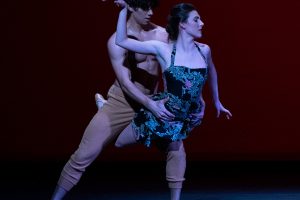
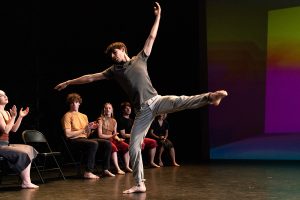

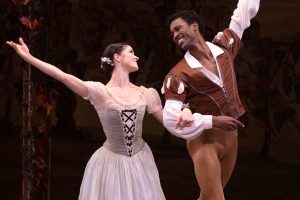

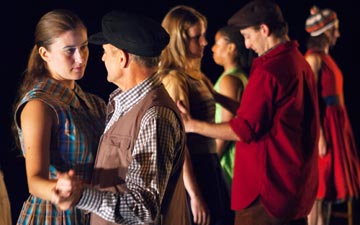

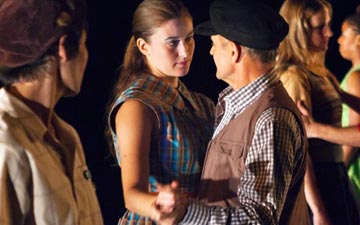
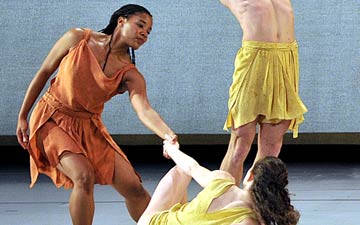

You must be logged in to post a comment.